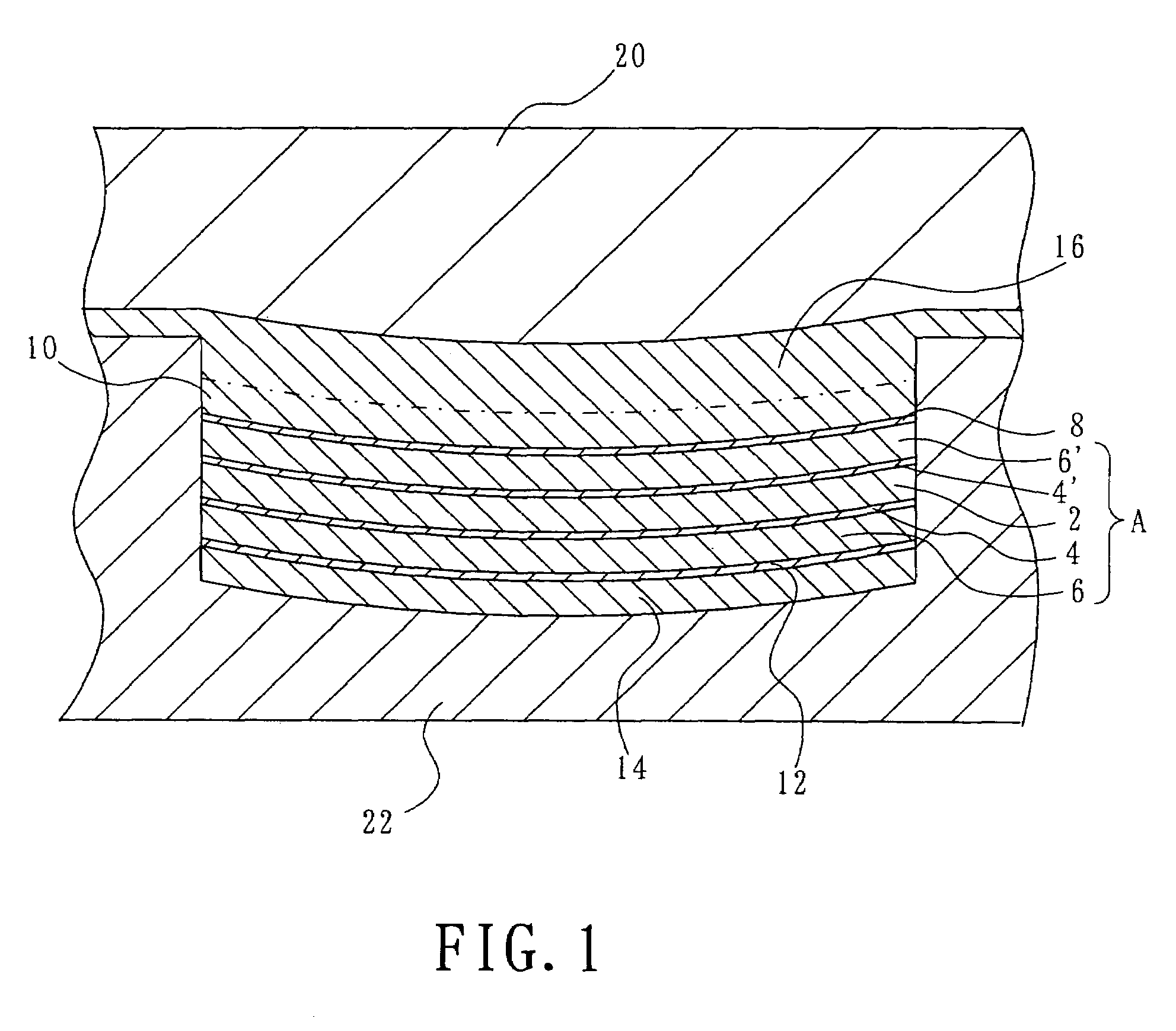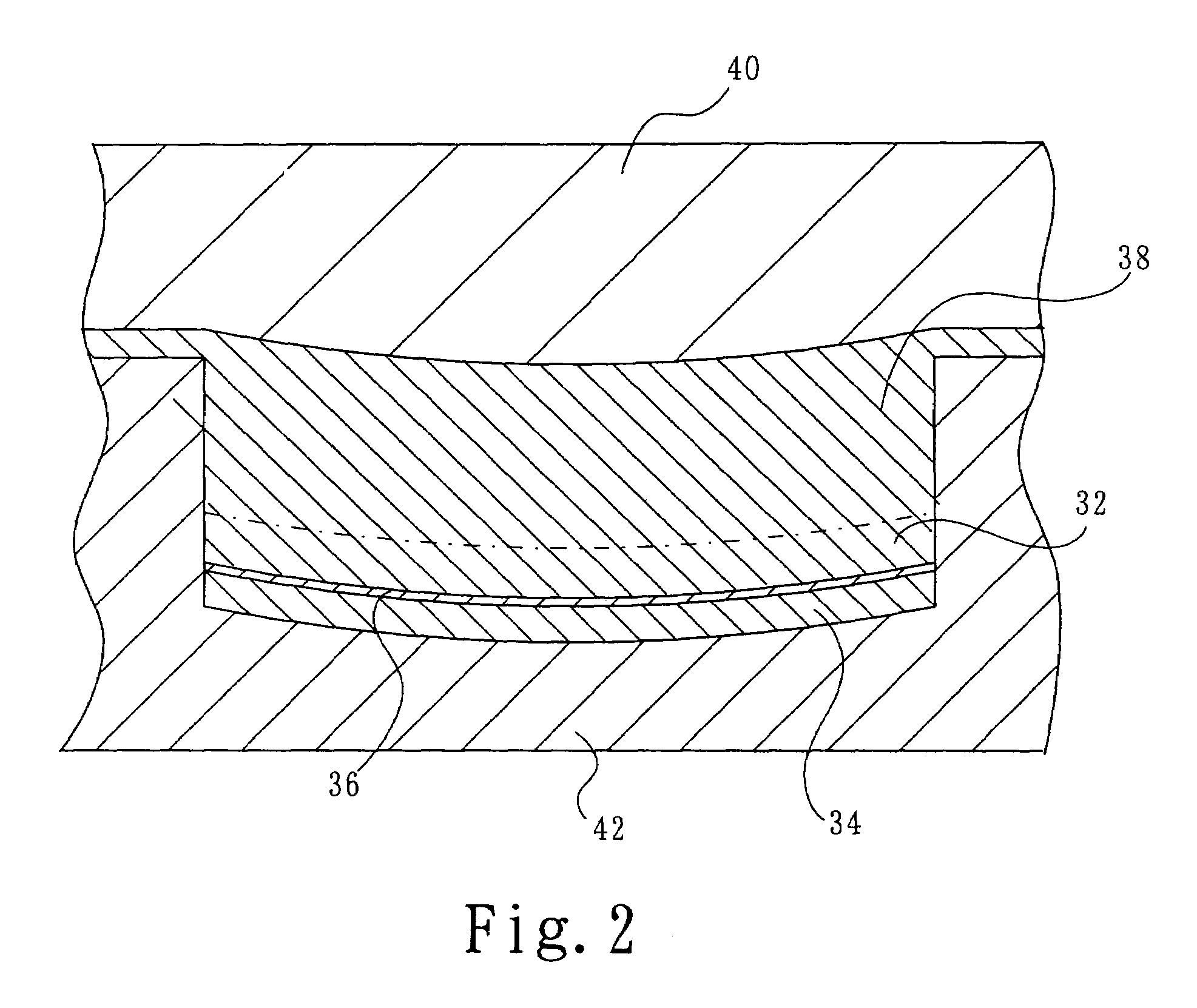Molded laminate for optical use
a technology of optical use and molded laminate, which is applied in the field of molded laminate for optical use, can solve the problems of inability to mix inorganic photochromic compound with plastic lens materials to produce transparent lenses, and is less effective in protecting eyes, and achieves the effect of high degree of polarization and small quantity production
- Summary
- Abstract
- Description
- Claims
- Application Information
AI Technical Summary
Benefits of technology
Problems solved by technology
Method used
Image
Examples
example 1
[0039]A polarizing sheet available from Sumitomo Chemical Company, Limited, known as SUMIKALAN® SQ-1852A, having a thickness of 0.18 mm and a light transmissivity of 43.7%, was used. The polarizing sheet includes first and second cellulose triacetate films each having a thickness of 0.08 mm onto the respective opposing surfaces of a polarizing film of polyvinyl alcohol dyed with an iodine-type dye stuff. The polarizing film has a thickness of 0.02 mm and a degree of polarization of 99.95%. A polycarbonate resin film having a thickness of 0.15 mm and having a light transmissivity of 89%, which is compatible and fusible with a lens molding polycarbonate resin, was bonded to the exposed surface of the first cellulose triacetate film of the polarizing sheet, using a two-component type polyurethane resin as the adhesive.
[0040]Then, a third cellulose triacetate film, which was free of an ultraviolet absorber and had a thickness of 0.05 mm, was bonded to the exposed surface of the second c...
example 2
[0043]A polyallylate film, which had a thickness of 0.14 mm, exhibited a light transmissivity of 88%, and was compatible or fusible with a lens molding polyallilate resin, was bonded to the exposed surface of the first cellulose triacetate film of the same polarizing sheet as used in Example 1, by the use of a two-component polyether polyurethane resin adhesive.
[0044]Then, over the exposed surface of the second cellulose triacetate film, an adhesive was applied to a thickness of 0.01 mm, by means of which a third cellulose triacetate film free of an ultraviolet absorber having a thickness of 0.05 mm was bonded to the second cellulose triacetate film to thereby obtain a laminate sheet. The adhesive used to bond the third cellulose triacetate film to the second one was a two-component type polyester polyurethane resin to which 1.5% by weight, to the solid content of the two-component type polyester polyether resin, of the following was added:
1-(2-methoxy-5-nitrobenzyl)-3,3-dimethylspi...
example 3
[0046]A polycarbonate resin and a polybutylene terephthalate were uniformly blended in a weight ratio of 60:40, from which a transparent thermoplastic film having a thickness of 0.2 mm was prepared. Over the thus prepared transparent plastic film, the two-component type polyether polyurethane adhesive containing the photochromic compound same as used in Example 1 was applied to a thickness of 0.02 mm, over which a cellulose triacetate film free of an ultraviolet absorber having a thickness of 0.05 mm was placed to form a laminate sheet.
[0047]The laminate sheet was subjected to hot bending to a shape in which the exposed cellulose triacetate film exhibited convexity, while the exposed surface of the thermoplastic film exhibited concavity. The hot-bent laminate sheet was placed in an injection mold, and the same resin as the thermoplastic film was injected over the exposed surface of the thermoplastic film, to thereby form an optical lens having a thickness of 2.0 mm.
[0048]The light t...
PUM
| Property | Measurement | Unit |
|---|---|---|
| Length | aaaaa | aaaaa |
| Length | aaaaa | aaaaa |
| Length | aaaaa | aaaaa |
Abstract
Description
Claims
Application Information
 Login to View More
Login to View More - R&D
- Intellectual Property
- Life Sciences
- Materials
- Tech Scout
- Unparalleled Data Quality
- Higher Quality Content
- 60% Fewer Hallucinations
Browse by: Latest US Patents, China's latest patents, Technical Efficacy Thesaurus, Application Domain, Technology Topic, Popular Technical Reports.
© 2025 PatSnap. All rights reserved.Legal|Privacy policy|Modern Slavery Act Transparency Statement|Sitemap|About US| Contact US: help@patsnap.com


